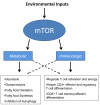mTOR, metabolism, and the regulation of T-cell differentiation and function
- PMID: 22889214
- PMCID: PMC3419491
- DOI: 10.1111/j.1600-065X.2012.01152.x
mTOR, metabolism, and the regulation of T-cell differentiation and function
Abstract
Upon antigen recognition, naive T cells undergo rapid expansion and activation. The energy requirements for this expansion are formidable, and T-cell activation is accompanied by dramatic changes in cellular metabolism. Furthermore, the outcome of antigen engagement is guided by multiple cues derived from the immune microenvironment. Mammalian target of rapamycin (mTOR) is emerging as a central integrator of these signals playing a critical role in driving T-cell differentiation and function. Indeed, multiple metabolic programs are controlled by mTOR signaling. In this review, we discuss the role of mTOR in regulating metabolism and how these pathways intersect with the ability of mTOR to integrate cues that guide the outcome of T-cell receptor engagement.
© 2012 John Wiley & Sons A/S.
Figures


References
-
- Lafferty KJ, Cunningham AJ. A new analysis of allogeneic interactions. Aust J Exp Biol Med Sci. 1975;53:27–42. - PubMed
-
- Bretscher P, Cohn M. A theory of self-nonself discrimination. Science. 1970;169:1042–1049. - PubMed
-
- Powell JD, Ragheb JA, Kitagawa-Sakakida S, Schwartz RH. Molecular regulation of interleukin-2 expression by CD28 co-stimulation and anergy. Immunol Rev. 1998;165:287–300. - PubMed
-
- Jenkins MK, Taylor PS, Norton SD, Urdahl KB. CD28 delivers a costimulatory signal involved in antigen-specific IL-2 production by human T cells. J Immunol. 1991;147:2461–2466. - PubMed
-
- Colombetti S, Basso V, Mueller DL, Mondino A. Prolonged TCR/CD28 engagement drives IL-2-independent T cell clonal expansion through signaling mediated by the mammalian target of rapamycin. J Immunol. 2006;176:2730–2738. - PubMed
Publication types
MeSH terms
Substances
Grants and funding
LinkOut - more resources
Full Text Sources
Other Literature Sources
Miscellaneous

